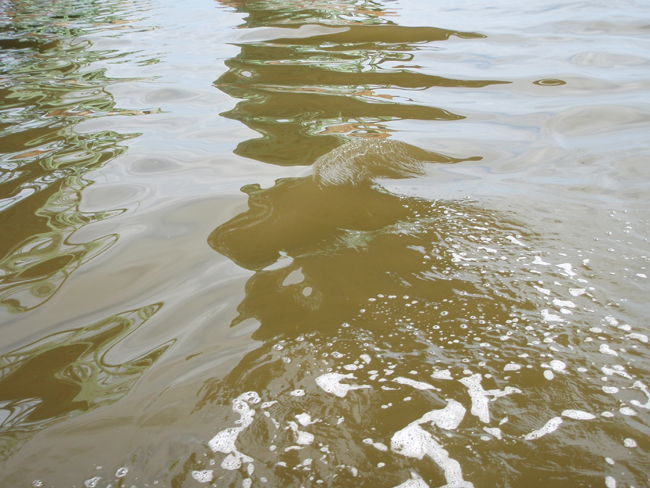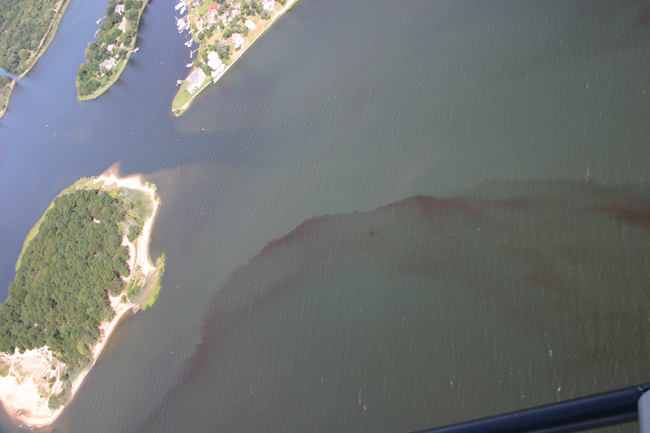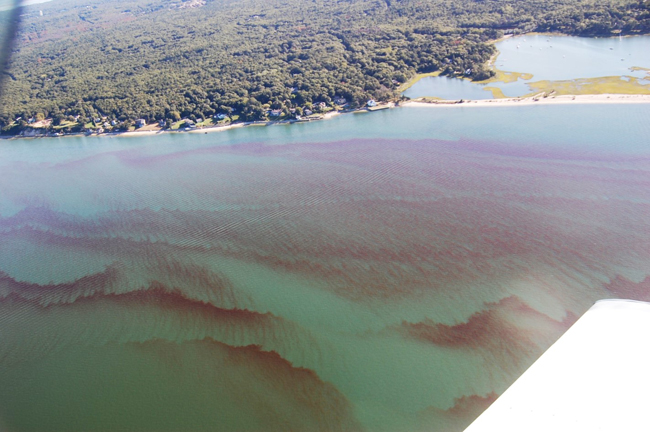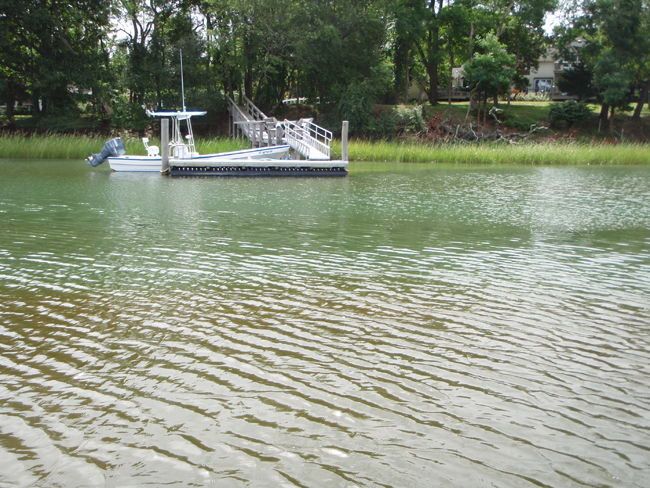
A harmful algal bloom (most likely from the alga Cochlodiniuma) caused this rust tide in Orient Harbor. Credit: Peconic Estuary Partnership.
Stony Brook, NY, May 15, 2020 - What Are Harmful Algal Blooms? Microalgae are photosynthetic organisms that live in marine and freshwater systems where they function as nitrogen and phosphate fixing organisms, and help to drive the dynamics in these habitats.
While there are thousands of algae species, a small subset (including diatom, dinoflagellate, and cyanobacteria), produce toxins that are harmful to humans, other animals, and the environment.
When toxic algae grow excessively, this phenomena is known as a harmful algal bloom (HAB). This problem is more common in the warmer months on Long island, where Suffolk County experiences at least five types of algal blooms, annually.
With the exception of green tide that was first documented in the early 1950s on the east end of Long Island, HABs only became of concern since the mid-1980s.
Unfortunately, HAB occurrences are becoming more frequent with increased intensity and toxicity. These events sometime can cause human health concerns and/or ecological impacts, which results in significant economic loss from bathing beach and shellfish harvesting closures, loss of fisheries, etc.
Toxic algal blooms contain chemically diverse compounds that are associated with different illnesses in humans, and can adversely affect certain fish, seabirds, reptiles and marine mammals.
For more information about various HABs that affect Suffolk County waters, please read the Harmful Algal Bloom Synthesis Report (pdf).

Brown Tide sighted in Great South Bay. West Islip, May 15, 2008. Credit: Suffolk County Department of Health Services.
Common Marine Algae Species
• Chlorophytes (Green Tide)
• Aureococcus spp. (Brown Tide)
• Alexandrium spp. (Paralytic Shellfish Poisoning)
• Blue-Green Algae
• Cochlodinium spp. (Rust Tide)
• Dinophysis spp. (Diarrhetic Shellfish Poisoning)

A red tide in Suffolk County's Flanders Bay, August 27, 2008. Credit: Suffolk County Department of Health Services.
Common Signs of Suspicious Algal Bloom
Clean water usually has a blue appearance. However, when algae blooms and becomes harmful, it sometimes causes discoloration, and water color can change to blue-green, green, red, brown, etc. Although water discoloration frequently accompanies harmful algal blooms, this isn’t always the case. Most HAB events must be confirmed by conducting diagnostic tests.

A 2016 toxic ‘rust tide’ in the Peconic Estuary. Credit: courtesy of US Coast Guard Auxiliary.
How You Can Help
Report Suspicious Algal Blooms
NYS Department of Environmental Conservation's Shellfish Unit, Suffolk County Department of Health, and Stony Brook University's School of Marine and Atmospheric Sciences collect data to monitor HAB events each season. These data are used as guidance to make decisions to promote public health and safety during times when HABs are most active.
We are asking for your help to document these occurrences in marine waters, by completing the Suspicious MARINE Algal Bloom Report form which will be sent to Suffolk County Department of Health Services.
Please use this form to report marine algal blooms, only.
You can also report a suspicious algal bloom in freshwater.
Thank you for using the Suffolk County Department of Health Services system to report a suspicious algal bloom. Information collected in this survey will be considered as public records.
Please contact michael.jensen@suffolkcountyny.gov with questions.

A brown tide bloom in West Neck Bay, Shelter Island Heights. Credit: Peconic Estuary Partnership.
References
Sournia, A. (1995). Red tide and toxic marine phytoplankyon of the world ocean: an inquiry into biodiversity. In A. G. Lassus P, Harmful marine algal blooms. (pp. 103-112). Nanes, France. Lavoisier, Paris: October 1993: Proceedings of the 6th International Conference on Toxic Marine Phytoplankton.
This project is partnership between New York Sea Grant and Suffolk County Department of Health Services Office of Ecology, funded under a New York Sea Grant Extension Development grant.
New York Sea Grant partnered with the Suffolk County Department of Health Services to develop the "Suffolk County Harmful Algal Bloom Action Plan," a springboard for mitigation strategies being implemented by Suffolk County government and the New York State Department of Environmental Conservation (NYSDEC) to improve water quality.
More Info: New York Sea Grant
New York Sea Grant (NYSG), a cooperative program of Cornell University
and the State University of New York (SUNY), is one of 34 university-based
programs under the National Oceanic and Atmospheric Administration’s
National Sea Grant College Program.
Since 1971, NYSG has represented a statewide network of integrated
research, education and extension services promoting coastal community
economic vitality, environmental sustainability and citizen awareness
and understanding about the State’s marine and Great Lakes resources.
Through NYSG’s efforts, the combined talents of university scientists
and extension specialists help develop and transfer science-based
information to many coastal user groups—businesses and industries,
federal, state and local government decision-makers and agency managers,
educators, the media and the interested public.
The program maintains Great Lakes offices at Cornell University, SUNY
Buffalo, SUNY Oswego and the Wayne County Cooperative Extension office
in Newark. In the State's marine waters, NYSG has offices at Stony Brook
University in Long Island, Brooklyn College and Cornell Cooperative
Extension in NYC and Kingston in the Hudson Valley.
For updates on Sea Grant activities: www.nyseagrant.org has RSS, Facebook, Twitter, and YouTube links. NYSG offers a free e-list sign up via www.nyseagrant.org/nycoastlines for its flagship publication, NY Coastlines/Currents, which is published quarterly. Our program also produces an occasional e-newsletter,"NOAA Sea Grant's Social Media Review," via its blog, www.nyseagrant.org/blog.